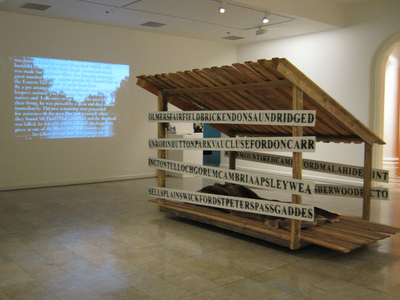Tresspass
Gough, Julie (2010) Tresspass. [Creative Work]
![[img]](https://researchonline.jcu.edu.au/19936/1.hassmallThumbnailVersion/TRESPASS.jpg)
|
Image (JPEG)
Download (533kB) |
|
|
PDF (Catalogue)
- Published Version
Restricted to Repository staff only |
Abstract
Trespass negotiates my frustration with Tasmania being enclosed, fenced and gated, and the difficulty for Aboriginal people to access their island without the permission of private landholders. In early 2008 I drove to Latrobe where, by the 1840s, my great great great great grandparents lived. Coal rd seemed a clue to the location of the Alfred Colliery that they founded and mined until it ran nigh dry after a decade. Asking a stranger who looked local on the main street brought me to an old-timer who told me where to look for what he thought was an entrance to the mine. Not on Coal rd, but not far off it lay, a black abyss hiding under the base of a burnt but alive grand old tree. I jumped a fence and hastened towards it, stopped suddenly by the booming voice of a man, striding down hill towards me. His broad accent, he was from Chester he later explained, seemed to bring me towards a colonial confrontation. Would I be shot? His increasing gait, it happened, was due to his concern for me because a large tiger snake lived at the entrance to the mine. However, I saw his rapid approach as a hostile response to my trespass. I remember the conjunction of both alarm and annoyance at my sense of guilt, caught wandering across what was originally not only my Aboriginal forebear's land, but also convict ancestor's land. Didn’t I have all ground covered? The man's arrival reawakened an anxiety that runs deep, about not being able to access my island home. Tasmania has been, since the first half of the 1800s, revised into a series of named 'properties'. Each has borne witness to the exclusion of the original people. Some properties have rivers that run through them, providing an arterial, subversive journey across places that hold close their secret pasts. Trespass is an imaginary vehicle on which I might journey through these places. Perhaps in dreams I would collect, remove, reorder the name planks along the byways and highways, reclaiming Aboriginal place.
Research Statement
| Research Background | This work was exhibited in a solo exhibition titled Rivers Run at Cairns Regional Gallery. This was an exhibition of five artworks that together reveal my ongoing physical and psychological engagement with Tasmania and its history. |
|---|---|
| Research Contribution | My process involves uncovering and representing historical stories to evaluate the impact of the past on our present lives. Combining found human made and natural materials from indoor and outdoor sites I manifest places that are anywhere and nowhere, internal worlds through which we might engage with our conflicting and subsumed histories. |
| Research Significance | Testing how I recognize my island and if it still recognizes me six generations since my tribal past, each piece is a fragment of the desire to recall and understand what happened in lethal frontier Van Diemen’s Land before it became amnesiac Tasmania. |
| Item ID: | 19936 |
| Item Type: | Creative Work |
| Media of Output: | Timber |
| Keywords: | Indigenous, Aboriginal, Australia, mixed-media, cross-cultural, colonisation, contemporary, exhibition |
| Additional Information: | Exhibited at Cairns Regional Gallery, 14 February - 5 March, 2010. |
| Funders: | This project was assisted through Arts Tasmania by the Minister for Tourism and the Arts |
| Date Deposited: | 13 Feb 2012 03:53 |
| FoR Codes: | 19 STUDIES IN CREATIVE ARTS AND WRITING > 1905 Visual Arts and Crafts > 190502 Fine Arts (incl Sculpture and Painting) @ 100% |
| SEO Codes: | 95 CULTURAL UNDERSTANDING > 9501 Arts and Leisure > 950104 The Creative Arts (incl. Graphics and Craft) @ 100% |
| Downloads: |
Total: 229 Last 12 Months: 3 |
| More Statistics |



